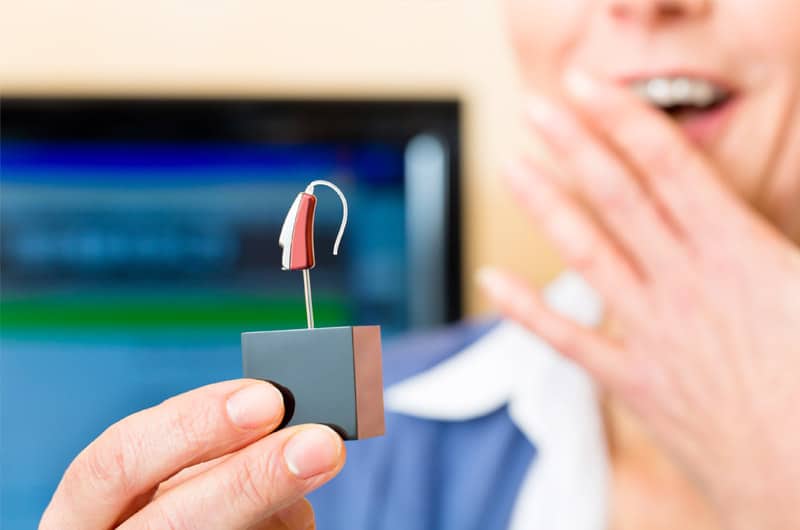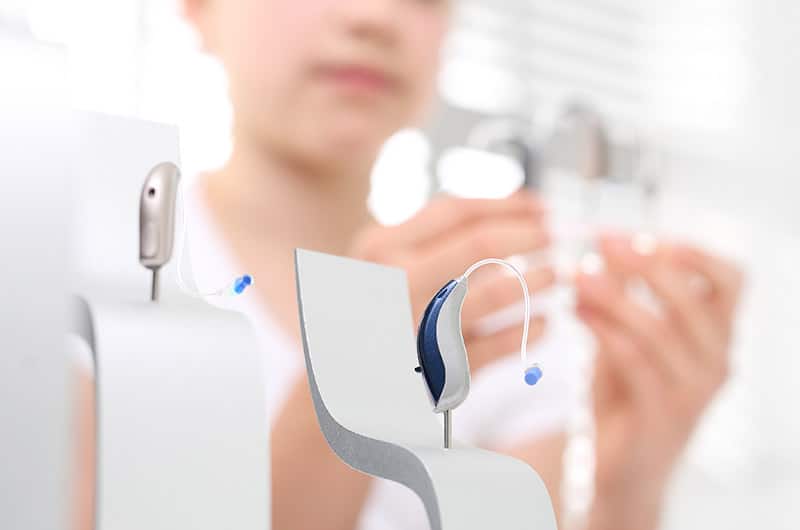The Benefits of Digital Hearing Aids

Hearing aids all have four main components: the microphone, receiver, battery, and amplifier. The amplifier is the part of the hearing aid that makes sound louder. In older analog technology, that was all the amplifier could do. With digital hearing aids, the amplifier is essentially a small computer. This allows the hearing aid to do more than just make sounds louder and enables a variety of additional features.
Feedback Cancellation – You may be familiar with the whistling sound that some hearing aids make. This is known as feedback. Analog hearing aids could control this noise by plugging your ear or removing the loudness for soft and high-frequency speech sounds. With digital hearing aids, they are able to remove the feedback noises completely, while still letting soft speech sounds through.
Directional Microphones – These are aspects of hearing aids that help to focus on specific voices while turning down the other ambient sounds. Analog hearing aids generally required pushing a button or switch to activate this feature. Today’s digital hearing aids turn on this feature automatically by reading the environment, and in some cases can tell the direction the sounds are coming from.
Music Programs – Analog hearing aids treat all sound the same, whether it’s speech or music. With digital hearing aids, there are some that can differentiate between voice and music and treat them differently. There are also custom programs designed specifically for music lovers to hear the different aspects of each song better.

Noise Management – This feature is used to help make people more comfortable. It works in loud and busy environments to help follow conversations, and also in everyday situations to block out repetitive, soft, and annoying sounds like refrigerators and computer fans. Analog hearing aids treated all sounds essentially the same and amplified everything. Digital hearing aids are now able to distinguish different noises using the computer technology in the amplifier. Environmental sounds can be almost completely ignored, loud noised turned down, and conversations tuned into.
Connectivity – With advancements in technology, connecting your devices is an ability people often look for. Analog hearing aids could connect to a few things commonly with a cord. Digital hearing aids are able to connect to a variety of devices wirelessly, including cell phones. This lets you hear phone calls through your hearing aid. You can also hear TV, music, and other forms of media using connectivity.
360 Degree Sound Experience
Traditional hearing aids were typically unidirectional. Wearers could only hear sound coming from one pre-set direction. However, digital hearing aids have changed this concept, and users can hear sounds coming from any direction around them. This helps your brain to better distinguish noise and speech.
Tinnitus support
Tinnitus is an ever-present annoying background buzzing noise in the ears that may be chronic. Modern hearing aids help ease tinnitus symptoms by masking these background buzzing noises.
Rechargeable Batteries
Rechargeable batteries are becoming more common in hearing devices, letting users avoid having to frequently change the small button batteries.
Apps
The smartphone apps that can be connected to modern hearing aids allow users to monitor battery charge, measure sound volume, and make adjustments.
They can also function similarly to assistive listening aids by sending sound from phone calls or other sources straight to a user’s hearing aids. Some may allow you to translate across languages and convert speech to text.
Water Resistant Design
Modern hearing devices are often made with a water-resistant casing which can help protect them against rain, sweat, and more.
Data Logging
Data logging enables the storage of data about your preferences for settings and features, as well as the listening environments in which you wear your hearing aids.
This data is vital because it can be used during a follow-up session by your hearing specialist to better tailor your devices.
The Benefits of Digital Hearing Aid Technology
- They enhance speech recognition even in noisy environments
- Tailored to match your needs
- They adjust your listening ability depending on your environment
- They come in compact, discreet sizes
- Feedback cancellation
How Digital Hearing Aids Work
Digital hearing aids feature three parts that enable users to distinguish sounds:
- Microphone – Picks up sound waves and transmits them as electrical impulses.
- Amplifier – Strengthens sound waves and transmits them into the ear.
- Receiver/speaker – Transforms the electrical signal’s amplification into sound and sends it to the ear canal.
The hearing specialists from Bravo Hearing Centre in Etobicoke understand the importance of finding the right hearing aid to meet your needs, as well as the importance of being able to live as you did prior to hearing loss. Our professionals are committed to providing the appropriate services and support based on the needs of each patient, including:
- Hearing tests
- Sales of hearing aids
- Hearing aid evaluations
- Aural rehabilitation programs
- Patient and family member counselling
The specialists at Bravo Hearing Centre can also recommend or provide the appropriate devices for individuals who require hearing protection for work or leisure activities.
For more information on the services and solutions provided by the specialists at Bravo Hearing Centre, see our hearing services page.
If you’re looking into upgrading your analog hearing aids or replacing your current digital hearing aids, call the hearing solutions specialists at Bravo Hearing Centre today at 647-694-4626 or contact us to discuss our available options.
Also Read:


